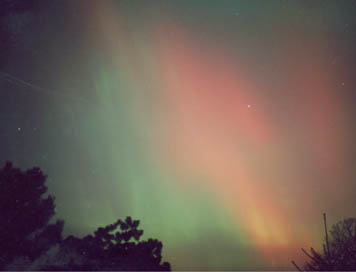Overview of the Solar System
The solar system consists of the sun and anything orbiting around it.
The Sun:
-
The sun has over 99.8% of the mass of the entire solar system.
-
The sun is ¾ hydrogen and ¼ helium (by weight).
-
It is a hot gas ... the layer you see below is called the photosphere and
is over 6,000°C (11,000°F).
-
Sunspots occur on the photosphere ... these can be thought of as a "magnetic
storm" which are cooler than the surrounding photosphere. Each individual
spot lasts about a week but about every 11 years lots of spots appear on
the sun. This is known as the sunspot
cycle.
-
Click here
or here to see a
current image of the sun.
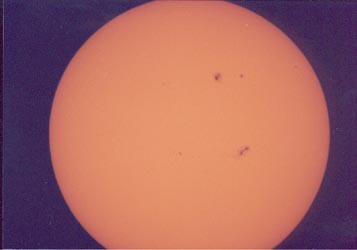
Taken April 28, 2000
The Terrestrial Planets
The 4 inner planets are all small, rocky and known collectively as the
Terrestrial
Planets.
The terrestrial planets (Mercury, Venus, Earth and Mars) have a high
density due to their rocky makeup.
Mercury
-
Mercury
looks very much
like the moon and not very interesting.
-
Once thought to be "earth's twin" because it was about the same size as
earth ... but U.S.S.R. probes in the 1960's showed it was very much different
from the earth.
-
Venus has a perpetual cloud cover ... the Magellan space probe used radar
to probe these clouds and obtain
images of the surface.
-
Venus has no water! Its surface is over 900 degrees F due to a
dense atmosphere of CO2 (a run away greenhouse effect). Could the earth
be heading towards these conditions? We discussed that possibility when we
discussed the carbon cycle.
-
Venus shows no evidence of plate tectonics! Most of the surface shows
evidence of major volcanic activity.
-
The mystery is ... is the surface still active? The evidence indicates
that the surface hasn't changed much in several hundred million years (based
on a very uniform meteor impact pattern) ... why? How, then does it
release the heat building up under the crust?
-
Venus has steep mountain ranges ... it was always a mystery how they "hold
themselves up" because it was always assumed the surface rocks would be
more plastic due the their high temperature. But recent experiments
show that even through the surface temperatures are high ... most of the
water has been driven out of the surface rocks making them extremely rigid!
So why doesn't plate tectonics work on Venus?
-
One idea suggests that Venus has a very thick rigid crust. This acts to
insulate the heat that must be trapped inside the planet (remember
radioactivity?). If that is the case, this trapped heat will build to a
point where the crust eventually cracks and the surface undergoes intense
volcanic activity (very much like a pressure cooker blowing its lid). Once
a large amount of heat escapes, the crust solidifies and goes dormant for a long
time. If that is the case, Venus will re-awaken and the surface will
become very active.
-
Mars is red (rusty) and about half the size of the earth. It has a thin
atmosphere of CO2 and no liquid water at the surface. Mars is an arid planet.
Mars is -63° C (-81° F) with a maximum temperature of 20° C
(68° F) and a minimum of -140° C (-220° F).
-
Mars has a similar tilt to its axis (so it has ice caps that change in size with
the seasons), and
it rotates on its axis in 24.6 hours.
-
This led early astronomers to speculate that "Martians" were drooling
over the prospect of invading earth.
-
In 1976, the US landed 2 Viking probes on the surface of Mars. It took
some good pictures
but found no life.
-
Mars has huge inactive shield volcanoes ... the largest is
Olympus
Mons which is three time the height of Mt. Everest and has a base the
area of Wisconsin.
-
Mars has Valles
Marineris: a canyon that would stretch from LA to NY. This canyon
was not formed by running water or plate tectonics but rather, as a result
of a stretching crust.
-
Mars once had running
water on its surface. This is only possible if the atmosphere
of Mars was much thicker than it is today. What happened to Mars?
-
In 1996 a team of astronomers examined a rock from Mars (which was blasted
off the surface by an impact and flung toward the earth). They found
tiny nanofossils
which suggest that life may have existed on Mars in its past. The
debate continues today due to the discovery of similar nanofossils in earth
rocks. We really will not be able to answer this question until we can
return rocks from the surface of Mars (without contamination with the earth of
any kind).
-
Does life exist on Mars today? A good place to look would be the
Martian ice caps but a probe scheduled to land there in 1999 never made
it :(
Asteroids
-
Asteroids are small rocky fragments which remind us of the state of the
solar system 4.6 billion years ago. The asteroid belt is just beyond
the orbit of Mars but on occasion, some asteroids get dislodged to orbits
that take them close to the earth. Then they become dangerous!
Space probes have close-up images of asteroids Eros,
Gaspra
, and Ida
The Jovian Planets
The next 4 planets are all very large and mostly gaseous. They are
collectively known as the Jovian Planets (Jupiter, Saturn, Uranus,
Neptune). These gas worlds have a large mass but have a low density.
At such a great distance from the sun, icy planetesimals were able to exist in
great numbers and the Jovian planets formed from these low density objects.
Although there is probably a solid surface deep inside, these planets are
essentially all atmosphere. All the Jovian planes have ring systems and
many satellites.
Jupiter
-
The largest planet with a turbulent atmosphere.
-
Jupiter has a giant "red
spot" ... a storm which has been seen for over 300 years.
-
Jupiter's moon IO
has active volcanoes (so does Neptune's moon, Triton).
-
The moon Europa
is ice covered but may have liquid water oceans flowing below the ice.
Saturn
-
Spectacular ring
system
-
Saturn's moon, Titan,
has an atmosphere and will be the target of a probe called Cassini due
to arrive in 2004.
Uranus & Neptune
-
Cold, gaseous, distant worlds. We are short on time!
Pluto (err sorry Pluto ... you are now off the list)
-
Last planet discovered (1930) and very small (even smaller than our moon).
-
It doesn't fit the "mold" of any other planet .... it isn't small and rocky
like the 4 inner (terrestrial) planets ... it isn't big and gassy like
the next 4 (Jovian) planets ... Pluto is small and icy!
-
In 1992, astronomers started finding all kinds of small icy "mini-plutos"
just beyond Neptune. It became apparent that Pluto actually did fit
somewhere ... as the largest one in this new class. This group of small
icy worlds is called the Kuiper Belt. Should we now
take Pluto off the list of planets and just make it the largest Kuiper belt
object? The vote is in ... Pluto is officially
off the list of planets but reclassified as a "dwarf planet" as of 8-24-2006 (sort of like
an honorary member).
The Kuiper Belt
-
Recently discovered small icy worlds just beyond Neptune. 1992 QB1
was the first found (or was Pluto?) but the list
is constantly growing. Hey,
2003 UB313 (nicknamed Xena) is even larger than Pluto ... maybe that
is why Pluto got the ax.
The Oort Comet Cloud
-
Comets are dirty
ice balls the size of mountains. The ices are frozen water and carbon
dioxide which are intermixed with small rocky fragments. Where do they come from? Jan Oort in 1950 speculated that they reside at the extreme limits of the solar
system ... well beyond the planets. Although astronomers can not
observe objects this small at such as great distance, it is assumed that
comets do indeed reside there. If a nearby star gravitationally nudges
some of these comets, they could find themselves propelled toward the sun.
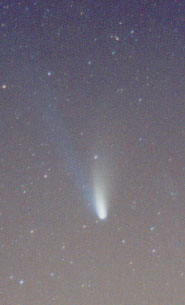
Comet Hale Bopp
|
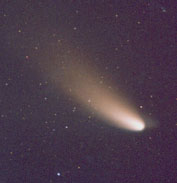
Comet Hale Bopp
|
-
The tail of the comet forms when it gets close to the sun and gasses evaporate
and rocky debris "flakes off" the comet.
Check these great sites on the solar system:
The Nine Planets
Views of the Solar
System
Astronomy Picture of the Day
ŠJim Mihal 2004 - all rights reserved


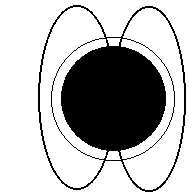 (animation)
(animation)
